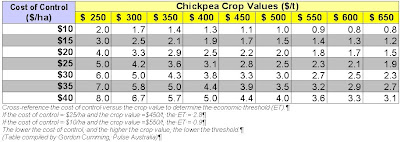With the approach of spring, helicoverpa start to become active. In CQ, chickpea crops are attractive to moths, and it is timely to revisit some of the key points related to making decisions about control of this pest in crops.In this article, I wanted to discuss a couple of the recommendations which some growers and agronomists have found a bit challenging. The first is adjusting larval density estimates to focus on those larvae that will cause damage.
1) Excluding very small larvae from threshold calculations. Estimating the number of very small larvae (VS) is time consuming to do in the field, and the accuracy of the estimate can be affected by the age and condition of the crop (figure 1). Whilst VS larvae are indicative of the size of the potentially damaging population in 2-3 weeks time, they are not relevant to a decision about controlling the current population to prevent yield loss.
Figure 1. Comparison of visual, beat sheet and absolute sampling for helicoverpa larvae on (a) dryland chickpea at late flower – pod fill, and (b) irrigated chickpea at mid flower to early pod set. VS=very small, S=small, SM=small-medium, ML=medium-large, L=large larvae. (Source: Melina Miles, 2004)
2) Applying a 30% mortality factor to small larvae. Essentially, applying mortality is acknowledging that a proportion of the population will not cause any yield loss because they do not survive to become medium and large larvae. Natural mortality is likely a result of dislodgement from the plant, disease, cannibalism, and predation. Remember that 80-90% of crop damage is caused by medium and large larvae.
This recommendation is based on trial work, largely in CQ, in which we followed infestations of helicoverpa and determined what proportion of the starting population of small larvae survived to large. The level of survival was variable between fields, but on average we determined that 70% of small larvae died before they reached large. In making a recommendation to include
In practice, in calculating how many larvae per m2 are likely to contribute to yield loss in the crop if left untreated, the following equation be used:

3) One well timed spray should be enough.
A spray may need to be applied during late flowering if targeting small and medium larvae to prevent them causing damage to a podding crop when they are medium-large. However, treating a population to prevent damage to a vegetative or flowering crop offers no yield benefit.
Trial results show that, in chickpea, helicoverpa larvae cause very little damage to buds and flowers (Figure 2). This is quite different behaviour from that seen in mungbeans, for example, where larvae show a clear preference for buds and flowers. Chickpea leaves appear more palatable to helicoverpa larvae than that of mungbeans.

These observations are supported by yield data from time of spraying trials which shows no significant benefit in yield from applying a spray at flowering. Yield loss starts to occur when larvae are present in podding and filling crops (Figure 3).
Figure 3. The impact of helicoverpa on chickpea yield when controlled at different stages of crop maturity. Bars with the same letter are not significantly different from each other.
Remember
Only one application of Steward® (indoxacarb) per crop, with a cut off for use of 15 September in CQ, and 15 October in cooler regions. Currently there is no evidence of resistance to indoxacarb in helicoverpa populations from cotton, but there has been no testing of larvae from CQ, or from chickpea. I would encourage you to make collections from chickpea to send to Dr Louise Rossiter, NSW DPI, Narrabri. Contact Louise on 02 6799 2428 or [email protected].
Revised ready-reckoner for calculating the economic threshold
Economic Thresholds (larvae/m2) for Conventional Pesticides
Cross-reference the cost of control versus the crop value to determine the economic threshold (ET).
If the cost of control = $25/ha and the crop value =$450/t, the ET = 2.8
If the cost of control = $10/ha and the crop value =$550/t, the ET = 0.9
The lower the cost of control, and the higher the crop value, the lower the threshold.
(Table compiled by Gordon Cumming, Pulse Australia)
Your opinions and experience are important, so leave a comment on this article or helicoverpa management issues.
Maybe you would like to respond to the following questions:
– Is the revised ready-reckoner any easier to use?
– Would a threshold calculator be a useful tool? i.e. where you put sampling and crop data in (larval number and size, grain price, cost of control) and it calculates the threshold.
Article by Melina Miles




